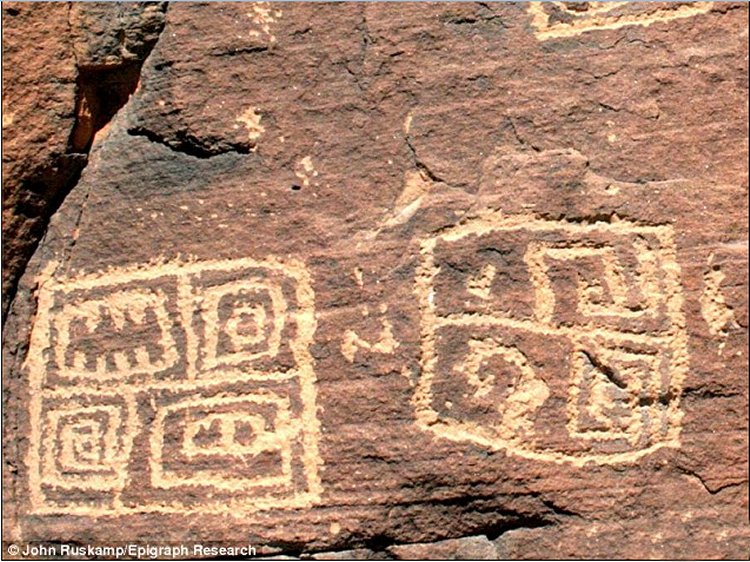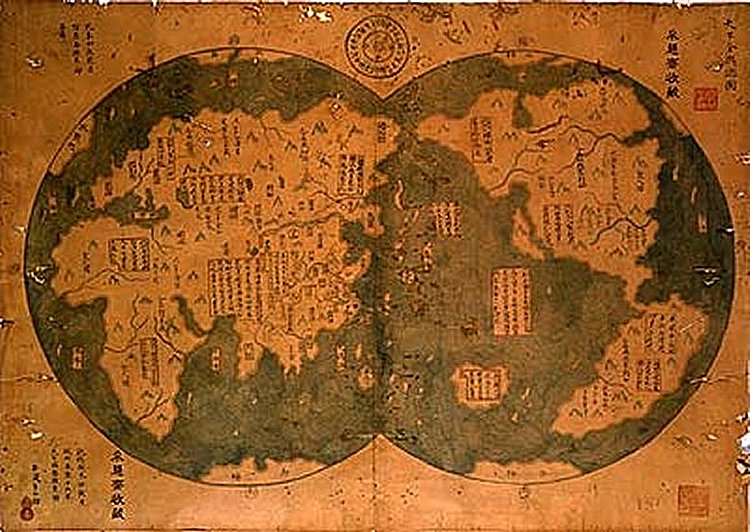Controversial Evidence – Ancient Chinese Visited America 2,500 Years Ago
A. Sutherland - AncientPages.com - Examination of rock carvings in Arizona and New Mexico has led scientists to the conclusion that "Chinese explorers not only reached the Americas in pre-Columbian times but that they interacted positively with Native populations, sharing both intellectual and cultural information."
In his science paper "Ancient Chinese Rock Writing Confirm Early Trans-Pacific Interaction", John A. Ruskamp, Jr., Ed.D. explains how many symbols carved on the North American rocks are ancient Chinese script petroglyphs.
Ancient Chinese script petroglyphs in the Petroglyph National Monument. Image credit: John A. Ruskamp
Ruskamp discovered the ancient signs while walking around Albuquerque's Petroglyph National Monument.
Some of the signs struck him as unusual, and he decided to consult with experts on Native American rock carvings and compare them with symbols he remembered from ancient Chinese scripts.
His analysis has led him to believe that the sign carved on the rocks offers intriguing proof Chinese explorers visited this part of the world thousands of years ago.
Ruskamp discovered ancient written Chinese symbols of Xiàn (to offer in worship to the deceased ancestors); Quăn (dog); Dà (great); Jié (to kneel down in reverence); Dà Jiă (the name of the third king of the Shang dynasty); and Gèng (the seventh Chinese Heavenly Stem).
Ancient Chinese pictograms were inserted over their corresponding petroglyphs. Image credit: John A. Ruskamp
Ruskamp is not the only scientist convinced ancient Chinese visited North America. David N. Keightley, Ph.D., who was the first to recognize the name of the Shang king, Dà Ji?, upon this boulder, also confirmed that these petroglyphs have the form of Chinese scripts.
Additionally, Michael F. Medrano, Ph.D., Chief, Division of Resource Management for Petroglyph National Monument, personally evaluated the petroglyphs upon this boulder on November 13, 2013.
With more than 25 years of experience working at the Monument with local Native cultures, upon viewing these figures, Medrano commented, "these images do not readily appear to be associated with local tribal entities," and "based on reputation appear to have antiquity to them."
According to Ruskamp, it isn't easy to physically date petroglyphs with absolute certaint. Stilll, the syntax and mix of Chinese scripts found at these two locations correspond to what experts would expect explorers from China to use some 2,500 years ago.
Several scientists have questioned the idea that Columbus discovered America. An ancient Chinese map dated 1418 reveals that Zheng He, a Chinese admiral whose fleets roamed the oceans between 1405 and 1435, visited the continent before Columbus.
His exploits, which are well documented in Chinese historical records, were written about in a book that appeared in China around 1418 called "The Marvellous Visions of the Star Raft."
Six Chinese characters in the upper right-hand corner of the map say this is a "general chart of the integrated world". In the lower left-hand corner is a note that says the chart was drawn by Mo Yi Tong, imitating a world chart made in 1418 which showed the barbarians paying tribute to the Ming emperor, Zhu Di.
According to Gunnar Thompson, a student of ancient maps and early explorers, the map "will revolutionize our thinking about 15th-century world history."
Ruskamp's discovery of the Chinese symbols in Arizona and New Mexico has drawn the attention of other scientists.
Updated on March 14, 2022
Written by – A. Sutherland - AncientPages.com Senior Staff Writer
Copyright © AncientPages.com All rights reserved. This material may not be published, broadcast, rewritten or redistributed in whole or part without the express written permission of AncientPages.com
More From Ancient Pages
-
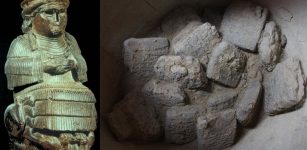 Sensational Find: Huge Cuneiform Archive Of Mysterious Ancient Clay Tablets Discovered In Iraq
Archaeology | Oct 26, 2017
Sensational Find: Huge Cuneiform Archive Of Mysterious Ancient Clay Tablets Discovered In Iraq
Archaeology | Oct 26, 2017 -
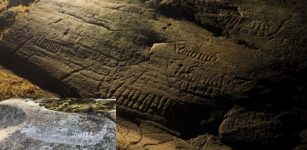 Ancient Petroglyph Code Cracked By Archaeological Explorers
News | Apr 10, 2020
Ancient Petroglyph Code Cracked By Archaeological Explorers
News | Apr 10, 2020 -
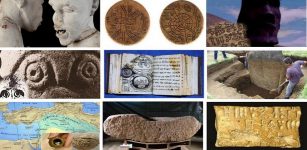 10 Mysterious Undeciphered Ancient Scripts, Tablets, Codes And Maps
Artifacts | Sep 16, 2014
10 Mysterious Undeciphered Ancient Scripts, Tablets, Codes And Maps
Artifacts | Sep 16, 2014 -
 Mythical Biringan City – Invisible Portal To Another World Where Dangerous Engkantos Reside
Featured Stories | Feb 2, 2018
Mythical Biringan City – Invisible Portal To Another World Where Dangerous Engkantos Reside
Featured Stories | Feb 2, 2018 -
 Amrita: Potion Of Immortality Consumed By Gods To Make Them Strong And Immortal
Featured Stories | Apr 5, 2019
Amrita: Potion Of Immortality Consumed By Gods To Make Them Strong And Immortal
Featured Stories | Apr 5, 2019 -
 Ivan The Terrible: Military Arsenal Unearthed Near Moscow
Archaeology | Jan 2, 2016
Ivan The Terrible: Military Arsenal Unearthed Near Moscow
Archaeology | Jan 2, 2016 -
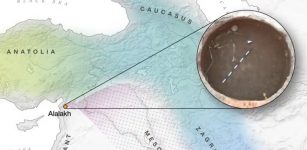 Mysterious Ancient Remains Of The Lady In The Well – An Archaeological Detective Story
Archaeology | Sep 11, 2020
Mysterious Ancient Remains Of The Lady In The Well – An Archaeological Detective Story
Archaeology | Sep 11, 2020 -
 The Faery Grail Of Hospitality And Accord – Secrets Of The Elucidation – Part 2
Ancient Mysteries | Sep 27, 2019
The Faery Grail Of Hospitality And Accord – Secrets Of The Elucidation – Part 2
Ancient Mysteries | Sep 27, 2019 -
 Drinking Horn: Important Yule Symbol And Its Connection To Biblical Magi And Christmas
Christmas Traditions | Dec 25, 2024
Drinking Horn: Important Yule Symbol And Its Connection To Biblical Magi And Christmas
Christmas Traditions | Dec 25, 2024 -
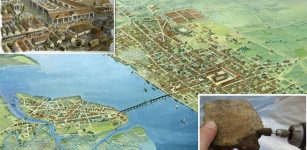 London Is Twice As Old As Previously Thought – New Discovery Reveals
Archaeology | Apr 9, 2020
London Is Twice As Old As Previously Thought – New Discovery Reveals
Archaeology | Apr 9, 2020 -
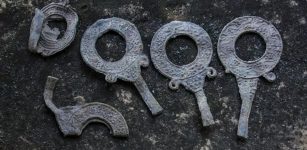 Five Ancient Mirror Frames, Ceramics Factory Found In Intriguing Roman Villa In Pavlikeni, Bulgaria
Archaeology | Mar 13, 2018
Five Ancient Mirror Frames, Ceramics Factory Found In Intriguing Roman Villa In Pavlikeni, Bulgaria
Archaeology | Mar 13, 2018 -
 On This Day In History: England’s Act Against Multipliers Signed Into Law – On Jan 13, 1404
News | Jan 13, 2017
On This Day In History: England’s Act Against Multipliers Signed Into Law – On Jan 13, 1404
News | Jan 13, 2017 -
 Yenikapı Excavations Reveal 8,500-Year-Old Artifacts
Archaeology | Jan 10, 2016
Yenikapı Excavations Reveal 8,500-Year-Old Artifacts
Archaeology | Jan 10, 2016 -
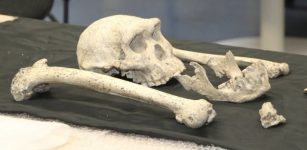 Can Fossil Teeth Confirm The “Big Brain – Long Childhood” Hypothesis?
Evolution | Nov 15, 2024
Can Fossil Teeth Confirm The “Big Brain – Long Childhood” Hypothesis?
Evolution | Nov 15, 2024 -
 On This Day In History: Macbeth, King of Scots Killed At The Battle Of Lumphanan – On August 15, 1057
News | Aug 15, 2016
On This Day In History: Macbeth, King of Scots Killed At The Battle Of Lumphanan – On August 15, 1057
News | Aug 15, 2016 -
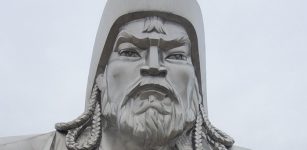 Avraga In Eastern Mongolia Was Winter Base Camp Of Genghis Khan – Study
Archaeology | Jul 8, 2020
Avraga In Eastern Mongolia Was Winter Base Camp Of Genghis Khan – Study
Archaeology | Jul 8, 2020 -
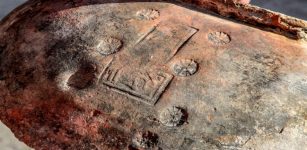 2,500-year-old Saka settlement found in Lake Issyk-Kul: could this be where St Matthew is buried?
Civilizations | Sep 4, 2015
2,500-year-old Saka settlement found in Lake Issyk-Kul: could this be where St Matthew is buried?
Civilizations | Sep 4, 2015 -
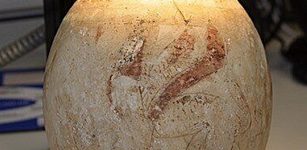 5,000-Year-Old Mystery: Decoration Of Eggs Predates Our Easter Tradition
Archaeology | Apr 9, 2020
5,000-Year-Old Mystery: Decoration Of Eggs Predates Our Easter Tradition
Archaeology | Apr 9, 2020 -
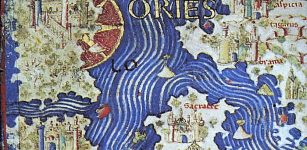 Fra Mauro Medieval Map: Accurate And Detailed Work Attesting To Advanced Geographic Knowledge Of Contemporary Cartographers
Artifacts | Feb 8, 2019
Fra Mauro Medieval Map: Accurate And Detailed Work Attesting To Advanced Geographic Knowledge Of Contemporary Cartographers
Artifacts | Feb 8, 2019 -
 Strange And Scary Encounter With Ancient Giants In North America
Ancient Mysteries | Sep 23, 2021
Strange And Scary Encounter With Ancient Giants In North America
Ancient Mysteries | Sep 23, 2021




